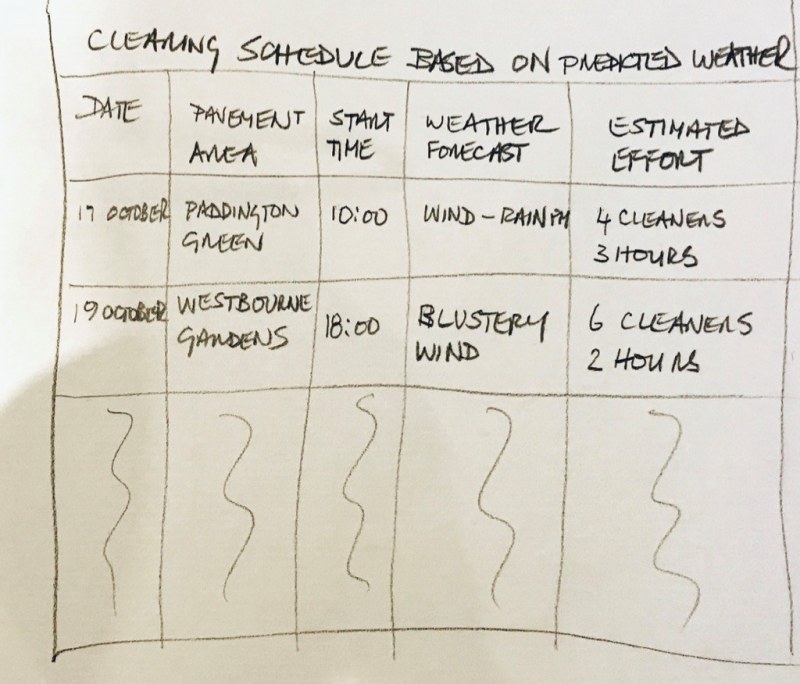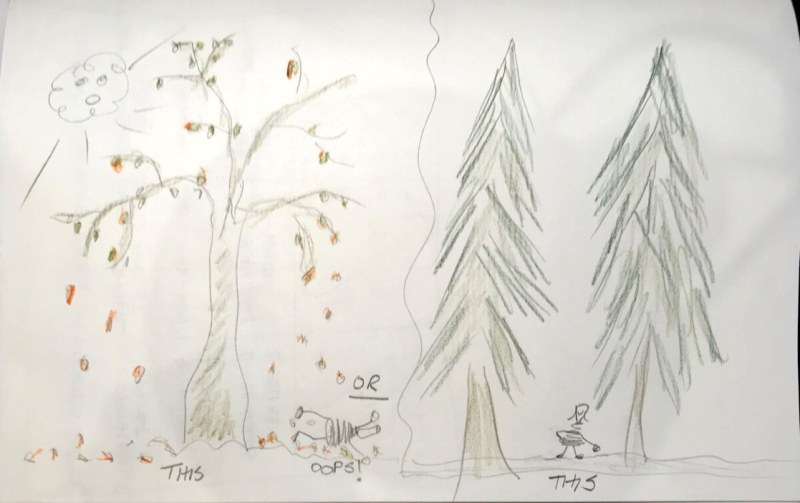Suzanne Robertson James Robertson
How Will It Work?
The Future How Viewpoint.
In a previous article *Business Analysis Viewpoints* [1] we discussed a number of ways of looking at systems. The intention of these viewpoints is to make it easier to see and understand the real business problem. This article focuses on the fourth viewpoint, the *Future-How*, which looks at the solution to the business problem. It does this by assessing alternatives, and then choosing the best solution to that real business problem.
Identifying Alternative Solutions
- Let’s suppose that you have done enough analysis to identify the real business problem. In the previous article mentioned above, we investigated the problem of removing fallen leaves from footpaths in autumn. Leaves need to be removed as quickly as possible – leaves can be dangerous and slippery, especially in wet weather (it’s autumn remember). The intention is to make the footpaths as safe as possible for pedestrians and thereby avoid accidents caused by slippery leaves.
Instead of fixing on the first solution that comes to mind, it makes sense to come up with a number of alternatives. By so doing, better solutions will probably emerge. Then you must be able to make valid comparisons and choose the most appropriate before defining its detailed requirements.
Some solution ideas for speeding up leaf removal might be:
- Schedule the leaf clearing teams in advance based on predicting when the leaves will fall so that the team can be deployed as rapidly as possible.
- Eliminate the leaves by cutting down the deciduous trees and replacing them with evergreens.
- Introduce leaf vacuum machines to remove the leaves and bag them in one operation.
- Provide an incentive for members of the public to clear the leaves. Make leaf bags available and pay a bounty for each full bag of leaves.
Probing Your Solutions
- In order to choose between your ideas for alternative solutions you can explore each one using a technique called Safe-to-Fail Probes. These are quick, small-scale experiments aimed at establishing the viability and acceptability of solutions. As the name suggests, if a solution fails, then very little is lost. The proposed solution was only a sketch and discarding it does not affect the project in any way.
Before probing a proposed solution, bring it to life. Illustrate it just enough to compare it with the other ideas. Use a mixture of sketches – possibly some kind of annotated rich picture, or process models – along with your probing questions. You are asking questions that probe the proposed solution for its pros and cons. You are testing the solution for feasibility and workability, along with its economics and conformance to constraints.
Here are some examples of safe to fail probes using the proposed solutions for the leaf removal problem.
-
Proposed Solution 1. Schedule and deploy the leaf clearing teams in advance based on predicting when the leaves will fall.

-
You can make the idea more specific by sketching a leaf clearing schedule and use it to help think of questions:
o How many days in advance would we need to predict the schedule?
o What are the normal start and end times of a leaf cleaner’s shift?
o Is there enough artificial light to do leaf clearing at night?
o Given that leaf clearing is limited to autumn, can we use casual labour?
o Is the weather forecasting accurate enough to predict when the leaves will start falling? -
Proposed Solution 2. Eliminate the leaves by cutting down the deciduous trees and replacing them with evergreens.

-
This would avoid the necessity to clear leaves.
o What effect would it have on leaf clearers’ jobs?
o No leaves mean no more pedestrians slipping.
o Are the deciduous trees protected? Do English Heritage or the local council or any other bodies have regulations regarding cutting down trees? -
Proposed Solution 3. Introduce leaf vacuum machines to remove the leaves more quickly and bag them all in one operation.

o How many leaf vacuum machines do we need and what is the estimated cost of buying them?
o What training is required for the leaf clearing staff to be able to operate the new machines?
o What is the best way of disposing of the full bags of leaves?
o Could we sell the bags of leaves to a fertiliser company? -
Proposed Solution 4. Provide an incentive for members of the public to clear the leaves. Make leaf bags available and pay a bounty for each full bag of leaves.
o Will members of the public be prepared to do this work?
o Maybe kids or school groups could make pocket money.
o Potential problem with timing due to availability, we need the leaves to be picked up as soon as they fall.
o Need council employees to supervise this work. -
By sketching, questioning and probing your alternative solutions you bring them to life and identify the solution or solutions that are the best fit for your problem.
After probing the leaf removal solution ideas with a variety of stakeholders, we have decided to go ahead with Solution Idea 3. Introduce leaf vacuum machines to remove the leaves more quickly and bag them all in one operation. We have also decided to take some ideas from Solution 1 and make better use of long-range forecasts when scheduling the leaf removal teams.
Defining the Solution Space
- Now, as the first step to identifying the detailed requirements, you can sketch out the scope of your chosen solution space. Use business events (covered in the first article in this series) to identify the functional chunks of the solution. Then use the business events to prioritise your work of building the solution. Here’s a diagram that summarises our intended solution scope after having done some safe-to-fail probes.

- Using business events to partition the solution space identifies 6 events:
- New weather forecast available. I/P Weather Forecasts, O/P Emergency Schedule
- Footpath condition monitored. I/P Footpath Location + Leaf Density
- Human Resources inform us of available workers. I/P Available Council Workers
- Council Worker has bags of leaves available for pickup. I/P Leaf Bag Locations. O/P Hours Worked, Leaf Pickup Request
- Time to schedule leaf vacuuming. O/P Daily Schedule + Tools, Request for Vacuum Machines.
- Machine Supplier supplies requested machines. I/P Leaf Vacuum Machines.
Then, depending on your goals, you choose the highest priority event and work on discovering the detailed requirements and developing the solution. For example, you might choose to start with event 5 because having an accurate schedule is so central to making the solution work. Or perhaps you start with event 1 because you want to learn more about how you will respond to weather forecasts of differing severity.
In this article and the previous one in this series we have introduced techniques for taking a number of viewpoints. Having the ability to look at the same problem from different points of view means that you have the focus to come up with more innovative ideas. Another plus is that it is much easier to plan and respond to changes.
Other sources of information about subjects discussed in the article:
- Business Analysis Agility: Delivering Value Not just Software amzn.to/2CnVhTN Video youtu.be/l_9u5UI12uo
- Reviews on many books by authors who continue to enrich the field of requirements and business analysis at volere.org/resources/books
- on the Volere Requirements LinkedIn group linkedin.com/e/vgh/2491512
Suzanne Robertson and James Robertson are principals and founders of The Atlantic Systems Guild and joint originators of the Volere requirements process, template, checklists and techniques.
You can contact the authors at
suzanne@systemsguild.net
james@systemsguild.net
Footnote
- [1] https://www.volere.org/wp-content/uploads/2019/08/BusinessAnalysisViewpoints.pdf
Suzanne Robertson is having a stellar career in information technology and systems engineering. Suzanne is a pioneer in adapting ideas from other domains for automated solutions. She has collaborated in workshops using experts from fields as diverse as modern music, visualization, and cookery. Ideas from these domains were adapted to make major breakthroughs in creative ideas for domains ranging from air traffic control to local government. She is co-author of the best-selling Mastering the Requirements Process, among other books and courses. She is co-creator of the Volere requirements techniques. She was the founding editor of the Requirements Column in IEEE Software.
James RobertsonAs a principal and founder of The Atlantic Systems Guild, James Robertson is known for his work in implementing systems engineering principles that link business specialists with solution specialists. James is a consultant, lecturer, author, project leader whose area of concern is the requirements for software, and the contribution that good business analysis makes to successful projects. James is co-author of 5 books that have been influential in the business analysis world. His training as an architect has led to his work on good design principles and to his focus on how innovation can be integrated with business analysis.